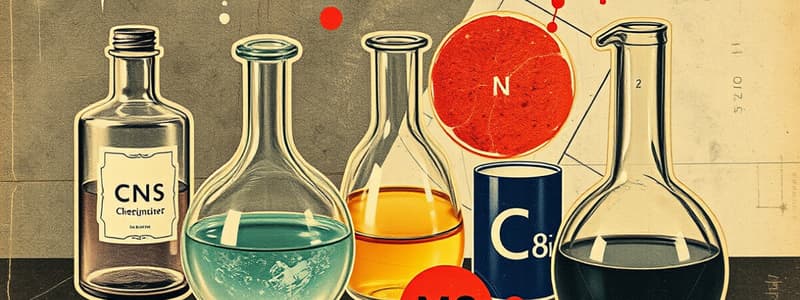Podcast
Questions and Answers
Air and water are both elements.
Air and water are both elements.
False (B)
All mixtures contain at least one element and one compound.
All mixtures contain at least one element and one compound.
False (B)
Compounds can be decomposed into two or more other substances; elements cannot.
Compounds can be decomposed into two or more other substances; elements cannot.
True (A)
Elements can exist in any of the three states of matter.
Elements can exist in any of the three states of matter.
When yellow stains in the kitchen sink are treated with bleach water, the disappearance is due to physical change.
When yellow stains in the kitchen sink are treated with bleach water, the disappearance is due to physical change.
The number 0.0033 has more significant figures than 0.033.
The number 0.0033 has more significant figures than 0.033.
Conversion factors used in converting units always have a numerical value of one.
Conversion factors used in converting units always have a numerical value of one.
Compounds always contain at least two different elements.
Compounds always contain at least two different elements.
Classify as mixture or pure substance: water
Classify as mixture or pure substance: water
Classify as mixture or pure substance: blood
Classify as mixture or pure substance: blood
Classify as mixture or pure substance: the ocean
Classify as mixture or pure substance: the ocean
Classify as mixture or pure substance: iron
Classify as mixture or pure substance: iron
Classify as mixture or pure substance: brass
Classify as mixture or pure substance: brass
Classify as mixture or pure substance: uranium
Classify as mixture or pure substance: uranium
Classify as mixture or pure substance: wine
Classify as mixture or pure substance: wine
Classify as mixture or pure substance: leather
Classify as mixture or pure substance: leather
Classify as mixture or pure substance: table salt
Classify as mixture or pure substance: table salt
Give two examples of elements.
Give two examples of elements.
Give two examples of compounds.
Give two examples of compounds.
Which of the following is neither an element nor a compound: blood, ocean, brass, wine, leather?
Which of the following is neither an element nor a compound: blood, ocean, brass, wine, leather?
Flashcards are hidden until you start studying
Study Notes
Fundamental Concepts in Chemistry
- Air is a homogeneous mixture, mainly composed of nitrogen and oxygen, while water is a pure substance.
- Mixtures can consist of elements, compounds, or a combination of both, offering flexibility in composition.
- Compounds can be broken down into simpler substances, whereas elements are the basic building blocks and cannot be decomposed further.
States of Matter
- Elements can exist in three states: solid, liquid, and gas, demonstrating their versatility in different conditions.
Chemical vs. Physical Changes
- The reaction of yellow stains in a kitchen sink with bleach water results in a chemical change, not a physical change, highlighting the transformation of substances.
Significant Figures in Measurements
- The numbers 0.0033 and 0.033 each have two significant figures, as leading zeros are not counted as significant.
Conversion Factors
- Conversion factors in unit conversions are always equal to one, ensuring consistency in measurement.
Classifying Substances
- Water is classified as a pure substance, while blood, the ocean, brass, wine, and leather are examples of mixtures.
- Elements such as iron and uranium are identified as pure forms found on the periodic table.
- Compounds like water and table salt consist of at least two different elements.
Summary of Classifications
- Pure substances include water, iron, uranium, and table salt.
- Mixtures include blood, ocean water, brass, wine, and leather, demonstrating a combination of various components without a fixed composition.
Studying That Suits You
Use AI to generate personalized quizzes and flashcards to suit your learning preferences.




